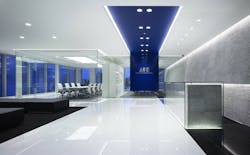It was confusing when promulgation and extension of the Digital Addressable Lighting Interface (DALI) was overtaken by the Digital Illumination Interface Alliance (DiiA), and now the solid-state lighting (SSL) industry organization will operate primarily under the DALI Alliance brand name. That change was implicitly made in an announcement by the organization of a new program to certify D4i sensors for integration into intelligent LED-based lighting products. The sensors can detect occupancy/vacancy and include connectivity control nodes for networked SSL installations.
As we have written before, the DiiA organization became responsible for promulgating the DALI standard back in 2017. The DiiA moved quickly to establish certification services for products to the DALI-2 standard published by the IEC in 2014 and adding testing procedures and the concept of DALI-2 control devices.
In the spring of 2019, the DiiA announced the extension of DALI-2 to support intra-luminaire communication whereas DALI had long been focused on inter-luminaire communications or connectivity between a master control system and a network of luminaires. That extension called D4i would ironically change the way forward for DALI and enable wireless inter-luminaire connectivity of luminaires with integrated intra-luminaire D4i interfaces. The organization soon began to certify D4i-based LED drivers for deployment.
Of course, D4i drivers must connect to a sensor and/or connectivity or control module to enable smart lighting scenarios. DiiA had turned to a partnership with the Zhaga Alliance to develop the electromechanical standards that would enable such as sensor or control module to be attached to a luminaire. Zhaga has developed its Book 18 specification for sensors that connect to outdoor luminaires and later Book 20 for indoor applications.
Now the rebranded DALI Alliance will began to certify D4i modules as guaranteed interoperable with LED drivers and the Zhaga-compliant sockets integrated into D4i-certified fixtures. The sockets can be populated with a sensor during the luminaire manufacturing process, or the network and intelligence features can be added in the field.
“Certification of D4i sensors and controllers is a significant milestone for our members and their customers,” said Paul Drosihn, DALI Alliance general manager. “The availability of qualified D4i control devices, alongside the many D4i drivers already available from numerous suppliers, brings further standardization to the market and simplifies the specification process.”
With the launch of DALI-2 back in 2014, the connectivity standard transitioned from a monolithic document to one with many optional parts and options. Luminaire-mounted control devices are specified in DALI Part 351 that was based on the IEC 62386 DALI 2 standard. Part 351 covers indoor and outdoor sensors, includes wireless-enabled network controllers, and spans sensors for ambient light, motion, and time.
The end result will be intelligent luminaires that can operate based on autonomous and programmatic scenarios. For instance, occupancy/vacancy can autonomously trigger a new light level. Or programmatically a street light could dim late at night because of an expected reduction in pedestrian or automotive traffic. The standards also support methodology for luminaires to store and report data for use in preventive maintenance and even billing by a utility. Outdoor lighting products, for instance, can report accurate energy usage data.
The standard has also been extended to support tunable-white SSL application with multiple channels of LEDs. For example, Acuity Brands and the eldoLED business unit were first to announce a tunable-white D4i certified LED driver back in February of this year. Signify, Inventronics and others have since made similar announcements.
For up-to-the-minute LED and SSL updates, why not follow us on Twitter? You’ll find curated content and commentary, as well as information on industry events, webcasts, and surveys on our LinkedIn Company Page and our Facebook page.





